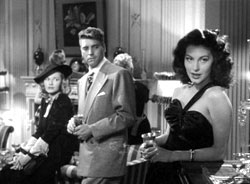
Film noir‘s subversive view of family life and women’s accepted role in society extends to its portrayal of the “good” or “normal” woman. The good woman embraces her traditional “place” in the family, but she is out of place in film noir. Although she offers the hero a chance to escape from the sexy, destructive femme fatale and the dangerous noir world, the good n proves to be a mirage that the hero cannot reach. She functions as a foil for the femme fatale, not as a realistic alternative or a prescription for female behavior. Indeed, Janey Place argues that “the lack of excitement offered by the safe woman is so clearly contrasted with the sensual, passionate appeal of the other that the detective’s destruction is inevitable.” 38 Ultimately, the good woman suggests that society’s prescription for happiness, the traditional family, is uninteresting and unattainable. The world of the good woman and “normal” family values contrasts sharply with the dominant world of film noir in both visual style and narrative content, as if the cultural ideal of family life — the dominant image of most Hollywood films at the time — is a mere fantasy for the noir characters. In film noir, the American dream is indeed a dream. The good woman often lives in an idealized country setting or in a well- kept apartment, outside of the dark, rain-soaked urban streets associated with the noir world. She is filmed using the visual techniques of classical Hollywood cinema: high-key lighting, eye-level camera angles, and open spaces — free of the disturbing mise-en-scène that surrounds the femme fatale. 39 And she remains passive, nurturing, and non-threatening — a redeeming angel for a hero hopelessly tempted by the active, independent, and dangerous femme fatale. 40
Within the context of film noir, the good woman and nuclear family life may seem “too good to last” — and they usually are. Ann, the idyllic but featureless good woman in Out of the Past, remains loyal to Jeff even when he tells her that he is mixed up with murder and another woman. The final scene of the film implies that Ann is not strong enough to know the truth about Jeff’s death and his continuing love for her; the Kid lies to her in order to make the rest of her life easier — perhaps suggesting that conventional family life is built on such lies. In The Big Heat, police detective Dave Bannion (Glenn Ford) first realizes that his family is vulnerable to the noir world when his wife receives a threatening phone call at home — she is later killed by a bomb planted in the family car. Thus, according to Janey Place, film noir depicts the good woman as an unlikely choice for the hero and sees the traditional family as an unsafe and undesirable refuge from the world outside:
On the rare occasions that the normal world of families, children, homes and domesticity appears in film noir it is either so fragile and ideal that we anxiously anticipate its destruction (The Big Heat), or, like the “good” but boring women who contrast with the exciting, sexy femmes fatales, it is so dull and constricting that it offers no compelling alternative to the dangerous but exciting life on the fringe. 41
As Place suggests, film noir exhibits a noticeable lack of balancing or prescriptive images of traditional women and families. Out of the Past contains no marriages at all, with the exception of a brief scene featuring Ann’s parents. In The Maltese Falcon (1941), Double Indemnity, Laura, and most other noir films, even the “good guys” are unmarried, have bad marriages, or express contempt for marriage. Sam Spade remarks that his murdered partner, Miles Archer, “had a wife who didn’t like him” — and Spade should know because he is having an affair with her. Barton Keyes, the insurance investigator and father figure in Double Indemnity, tells Walter that he once came close to marriage, but canceled the wedding after having his fiancée investigated. Laura’s detective Mark McPherson says simply that he has never been married, although a “dame” did get a fur coat out of him once.
Marriage and stable family life usually are denied to the hero of film noir, reversing the Hollywood formula of romance and melodrama that inevitably ends in marriage for the main characters. The femme fatale is too dangerous and must be destroyed, while the good woman is too far removed from the noir world of the hero. Thus, as Sylvia Harvey points out, film noir admits the possibility of marriage for the hero, only to deny its existence: “It is at the end of the movie [The Lady from Shanghai] a condition of the lonely and frustrating freedom of Michael (as well as for the crusading private eye in The Maltese Falcon, 1941) that he is not married, that marriage is an impossible state for him.” 42

Be First to Comment